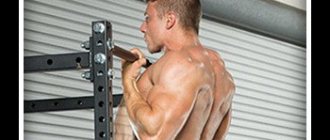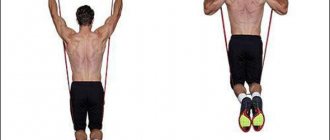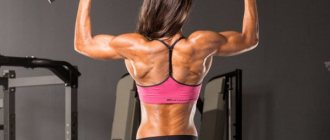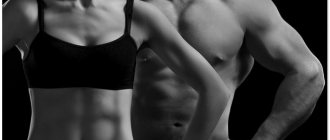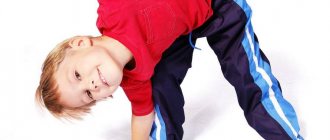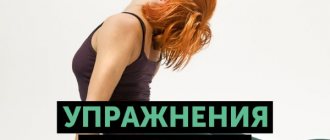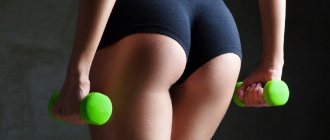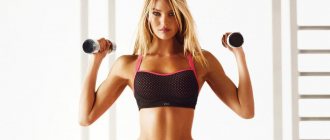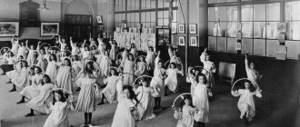The horizontal bar is a simple and very effective exercise machine, if, of course, you know how to use it correctly. It is in every yard, so it will not be difficult to use it for training. Thanks to such exercises, you can work out various muscle groups, and most importantly, the horizontal bar is suitable for both men and women. There are exercises for beginners and pros. If some tasks seem difficult to you, then try to complete them gradually. Do them for less time, gradually increasing it. Start with fewer sets. Everything will depend on your preparation, but you can start doing gymnastics on the horizontal bar from the very beginning level.
Pull-up technique
Many people can do pull-ups a small number of times, but to influence a specific muscle group, you need to perform the exercise correctly. As practice shows, even experienced and developed athletes do not always manage to do more than five pull-ups correctly. Before performing a pull-up program at home, a good warm-up and warm-up of the muscles is necessary. It is best to do push-ups from the floor several times and stretch your shoulder joints. When performing exercises on the crossbar at home, you must follow a certain technique.
- Maintaining correct body position . You need to fix your legs, you can fix them together and bend your knees at an angle of ninety degrees. In this position, lifting is carried out due to the strength of the arm muscles (the help of the legs and pelvis is excluded), and the work of the back is felt.
- Frequency and effort. To thoroughly work out the muscles, the exercise is best performed slowly, that is, lifting and lowering the body should be done at the same speed and evenly. There should be no jerking when moving. Hands must be kept tense. Muscle mass should be felt.
- Correct breathing: when ascending, inhale evenly, when lowering, exhale.
Press on the horizontal bar
In addition to developing your back muscles, you can very effectively pump up your abs on the horizontal bar.
Leg Raise
Once you reach the point where you can hang for 40-60 seconds, you can do various variations of abdominal exercises. For example, leg lifts.
There are two options here:
- Raising your legs with your knees bent.
- Army corner.
With the first option everything is clear. We raise our knees, twisting our pelvis behind them to maximally load the abdominal muscles.
In the second option, you need to lift your legs straight and touch the crossbar with them. By the way, if you then move your legs behind the horizontal bar, you will perform the “lifting with an inversion” element. But it’s still too early to try this element.
The Army Corner is an excellent horizontal bar exercise for beginners that will comprehensively strengthen your abdominal and core muscles, as well as your upper legs.
Crunches
Hang from the horizontal bar. Raise your legs bent at the knees alternately to the right and left. This way you pump up the oblique abdominal muscles.
Recommendations for working on the press
These tips are a lot like the tips for doing pull-ups:
- Don't sway - inertia makes the exercise easier. If you still sway, stop.
- Do everything smoothly and without jerking.
- Breathe correctly.
- If your hands slip, put on gloves. You can’t practice in this state – you might break down.
Varieties of grips when performing pull-ups
Not everyone training at home pays attention to the position of their hands on the horizontal bar, but it is the grip that determines which muscle group the main load will be directed to. The grip of the bar varies as narrow, medium and wide.
- Narrow - used to train the forearm and biceps, excluding the action of the back muscles, performed with the arms as close as possible.
- Medium - the position of the hands corresponds to the width of the shoulders. The load is distributed evenly. The arms, shoulders and back are equally involved in raising the torso. The most common grip when doing pull-ups.
- Wide - performed with the greatest mutual distance between the hands. To create the greatest load, the thumb does not wrap around the horizontal bar. Designed to train the back muscles.
Training in advanced exercises
Having mastered the basic tricks on the horizontal bar, you can move on to more complex ones. The next most difficult exercises are climbs; they can be very easy or really difficult. To do them, you need to develop endurance and a sense of balance.
Lifts with inversions
Performed using a direct grip. Having pulled yourself up, you need to move your upper body forward and throw your legs over the bar. After this, a revolution is carried out and the arms reach straight above the crossbar.
Feather lifts
They are a complicated version of the previous technique; when performing it, the body should not touch the horizontal bar. To do this, when pulling up, you should push off with your feet and do a push-up at the same time.
Kip-ups or riveting
They are done without pull-ups; to perform them, the legs rise to the crossbar of the horizontal bar, dive, and the athlete comes out with straight arms. This trick is a bit complicated and is learned in parts.
After learning these tricks, you are allowed to move on to the next stage of training. During its course, an already experienced athlete will be able to perform the techniques that he chooses from a wide range of options. It can be:
- two-handed outputs
- "angel exits"
- Spanish exits and many other tricks on the horizontal bar.
With the acquisition of the necessary experience, any restrictions are removed, the main thing is not to forget about safety precautions.
Different goals - different techniques
By doing pull-ups you can develop both strength and muscle mass. To learn how to competently do a certain slope, you need to remember what this exercise consists of. It consists of two stages:
- Positive phase - body lifting
- Negative phase - lowering the body
These phases are present in all strength exercises and are worth considering in more detail.
To generate force:
- Within three seconds, slowly raise the body, and lower it quickly - in one second.
- Gradually increase the number of approaches
- Create muscle tension when lifting
- Rest between sets for no more than two to three minutes.
Working for mass:
- Raise your torso quickly for one second and slowly lower it in about three seconds.
- Constant number of approaches without increasing
- When lowering the body, the muscles should be as tense as possible
- Rest between sets for more than three minutes
- After training at home, take a sufficiently energy-rich diet.
As you can see, the weight pull-up program at home has the opposite bias than for strength development.
When pull-ups are easy, you can use weights to make the exercise more difficult at home. To increase your own weight, belts with weights attached to them, leg weights, and backpacks with sand are used. The load weight is added gradually. It should be borne in mind that when working with weights, you must be careful so as not to cause harm to the body. Experienced athletes practice pull-ups with one arm, the second is behind their back, but here you need to have great strength and dexterity.
Exercises on the horizontal bar
25>
On the crossbar, strength and mainly swing exercises are performed - pull-ups, lifts, flips, revolutions, turns, swings, flights, somersaults, dismounts. Gymnasts perform a huge number of elements, varied in motor forms, technical solutions, and performance styles. There are about 200 types of exercises on the crossbar, and the number of elements exceeds 1000. They help strengthen the muscles of the arms, shoulder girdle and torso, improve coordination of movements, and spatial orientation. When performing exercises on the crossbar, inertial forces are manifested, sometimes exceeding the weight of the gymnast by 5–6 times (up to 400 kg or more), so students have to experience long-term overloads both in the head-pelvis direction (high rotations) and in the pelvis-head direction (revolutions in stops, riding, forward and backward). Most exercises on the bar come down to hanging and supporting movements, as well as transitions from one position to another. The success of these actions largely depends on technically correctly performed hanging, support and hand grip on the bar of the crossbar.
While hanging, it is necessary to stretch out as much as possible by increasing mobility in the shoulder joints, the head is slightly tilted forward, which ensures the most natural distribution of muscle tone involved in maintaining a given body posture, the arms are shoulder-width apart or narrower.
The design of the crossbar and its main dimensions are shown in Figure 29.
Rice. 29. Crossbar device
Due to the fact that during the swing movements the load on the hands increases and decreases, the student must change the strength of the grip, strengthening and weakening it accordingly. This makes it possible to relax and not rub the skin of your palms so quickly. Under the influence of strong friction against the crossbar, your hands can be injured. To avoid this, the first two or three sessions on the bar should be done very carefully in order to prepare the palmar surfaces of the hands.
With the current level of development of sports technology, a gymnast has to train on the horizontal bar often and for a long time. Even well-prepared palm surfaces cannot withstand heavy loads, as a result of which sometimes the gymnast breaks calluses and is out of action for a long time. To avoid tearing calluses, most gymnasts use special “overlays”, which are made of wicks or leather with a thickness of 1.5–2.0 mm.
Assistance and insurance are provided during exercises in such a way that the belayer stands at the site of a possible fall and is ready to support the student in the event of a fall.
Hanging pull-up . Performed from a hang on straight arms with an overhand grip (the position of the hang is fixed for 1–2 s). When pulling up, your legs are straight and your chin should be higher than the bar. It is prohibited to perform whipping movements with the legs. Training is carried out using the shin and thigh.
Raising straight legs to the crossbar . From a hanging position, with an overhand grip, without bending your arms, raise your straight legs and touch the bar with them, lower your legs to the starting position. Training is carried out with the help of: one hand - under the back, the other - behind the legs.
Lifting by inversion (Fig. 30). From hanging, pull yourself up with an overhand grip, raise your straight legs to the bar, continuing to pull yourself up and turn around it, go into emphasis on straight arms, bend your body (the position of the hang and support is fixed on straight arms for 1–2 s). Lowering into a hanging position is performed in an arbitrary manner. It is prohibited to perform whipping movements with the legs.
Rice. 30. Lifting with a coup
Sequence of learning: raising straight legs to the crossbar; rise by turning over with a push of one leg and swing of the other on a low crossbar; lifting by inversion with the help of pushing under the legs, back and shoulder; When going to point-blank range, hold the student by the legs.
Lifting by force (Fig. 31). From hanging on straight arms, pull yourself up and at a pace (without stopping) place your bent arm point-blank (elbow up); pressing your hands on the crossbar and pushing your shoulders forward, place your other hand at point-blank range; straighten them out; fix the emphasis on straight arms. Power lifting can be performed with both hands at the same time. Jerking and swinging movements are not permitted.
Rice. 31. Lifting by force
The sequence of learning: pull-ups with one hand placed point-blank using a grip on the shin and thigh; lifting by force with help - the same as in the previous exercise.
Pull-up swing . Pull up; raising your legs forward and slightly straightening your arms, bring your knees to the crossbar; Unbending and straightening your arms, send them forward and upward and stretch out as much as possible.
Swinging curves . From the hang, sharply raise your straight legs forward higher, and then, relaxing, energetically send your legs back and bend; swing forward, pressing with straight arms on the crossbar, bring your legs with your knees to the bar of the projectile; Unbending, send your legs forward and upward and stretch out as much as possible.
Arc swing (Fig. 32). From a stop, bending slightly, begin to move your shoulders back (head tilted to your chest), keeping your hips at the bar; moving your body forward, pressing your hands on the bar up and back, send your legs forward and up at an angle of no less than 45°; At the extreme point of the forward swing, stretch out as much as possible, maintaining a deep grip.
Rice. 32. Arc swing
Sequence of learning: on a low crossbar – swing in an arc with help, holding the student’s hips at the crossbar and directing the body forward and upward; help by supporting the hip and back; stand at the bottom on a high bar and carefully monitor the grip of your hands as you pull your body forward. In case of slipping on your fingers, prevent the fall by, if possible, restraining the student as soon as possible.
Swing in an arc with a turn in a circle in a hanging position with a different grip (Fig. 33). From a stop, bending slightly, begin moving your shoulders back (head tilted to your chest); holding your hips against the bar, moving your body forward, pressing your hands on the bar, send your legs forward and up at least 45° in the direction of the turn; Unbending and continuing to turn (helically from the legs to the torso), grab your hand, going into a hanging position with a different grip.
Rice. 33. Arc swing with a circle turn
The sequence of learning: from swinging in a hanging position with a forward swing - turning in a circle in a hanging position with a different grip; from emphasis on a low crossbar - swing in an arc with a turn in a circle while hanging while standing with a different grip; swing in an arc with a turn with help, at the beginning of the turn support under the back, and after the turn - under the chest.
Lifting the curtain with the right leg outside (Fig. 34). Vis; waving; swing forward to bring both legs to the crossbar and, swinging over with your right hand, grab the crossbar near your right hand with your popliteal fold; with the body moving backwards, swinging the left leg down and back and pressing the right leg on the crossbar, go to point-blank range; fix the bent position, the right leg is bent, the left leg is straight.
Rice. 34. Lifting the curtain with the right leg outside
Sequence of learning: on a low bar - lifting from a hanging curtain outside with the help of pressing the fly leg with your left hand, supporting it under your back with your right hand; in support, help fix the correct position, supporting with your left hand under the chest, and with your right hand - by the thigh of the swing leg; lifting the curtain outside with a running start on a low crossbar; lifting the curtain outside on a high crossbar with the help of pressing the swing leg with your left hand and holding it with your right hand when going to point-blank range.
Kip-up lift (Fig. 35). Vis; waving; swing forward, passing the vertical position, bring your feet toes to the crossbar; with the movement of the bent body backwards, unbending and holding your legs at the crossbar, point them up and forward (as if sliding along the crossbar) and, vigorously pressing with straight arms on the crossbar, come out point-blank; bend over and swing back higher.
Rice. 35. Kip-up
Sequence of learning: lying on the floor with a stick in your hands, imitate a kip-up; on a low bar from a hanging position, after bending, bring your legs toes to the bar and perform a kip lift with the help of holding the practitioner’s legs at the bar with your left hand and directing them forward and up, and pushing them under your back with your right hand; on a high crossbar from hanging at an angle - lifting with a kip; standing in front, take the student by the feet; move the body to the extreme rear position; release your legs and help lift with support under your legs and back.
Riding astride with the right (Fig. 36). Vis; waving; swing forward, bring both legs toes to the bar and immediately bring your right leg over the bar between your hands; with the body moving backwards, pressing with straight arms on the crossbar, point your legs forward and upward and come out on horseback; bend over; When lifting, do not move your left leg, which is on the outside, away from the crossbar. While standing, spread your legs wider.
Rice. 36. Riding astride right
Sequence of learning: imitate the movement using a gymnastic stick, for which, lying on your back, take the stick horizontally upward with a shoulder-width grip, raise your legs and swing your right over the stick, straighten up, sliding your legs along the stick to a lying position, and sit down; on a low bar from a hang with your legs bent apart - transition to a hang by bending over 2-3 times in a row (keep your legs at the bar); from the stop while riding on a low crossbar, lower yourself back into a hanging position, bent over and slowly perform a lift with the help of two people using your legs and back, and then lift astride a low crossbar with support for your leg and under your back; after that - astride a high crossbar with support under the pelvis and back.
Lifting forward into support from behind . With a forward swing, bend as much as possible, bring your legs to the bar and immediately bring them between your hands. Pressing the bar with straight arms, point your legs up and forward and, unbending, come out point-blank from behind.
Sequence of learning: on a low bar, from a support behind, perform a fall back into a hanging position, bent over, and lift forward into a support position from behind with support under your back.
Lifting with a backward swing (Fig. 37). Vis; waving; with a big swing back, bending and vigorously pressing with straight arms on the crossbar, from the moment you pass the vertical position, continuing to move your legs back and up, come to point-blank range. With a large swing, you must maintain a deep grip.
Rice. 37. Backstretch
Sequence of learning: mastering a large swing and holding the hands in a deep grip; lifting backwards with your feet resting on the hands of a friend providing assistance; lifting back in a swing with help provided from an elevated position (a goat, a horse standing on the side of the crossbar, or a special table), with one hand grabbing the student’s hand from above, and with the other first helping to perform a large swing, pressing on the shoulder from above, and then with By moving your body back, grab your hand under your stomach and help you come out point blank.
Turn back (Fig. 38). In an emphasis position, after a preliminary swing back with the body approaching the crossbar, actively send your shoulders back, pressing your hips against the crossbar with straight arms, at the same time, bending slightly, send your legs forward and up, and your shoulders back; Having passed the vertical position upside down, turn your hands, straighten up and go point blank.
Rice. 38. Turn back
Sequence of learning: on a low crossbar, slowly perform a rotation with the help of two people, rotating the student by the legs and shoulders; then - turn back without extension; Bend on a low crossbar, lowering your shoulders forward and down; turning your hands, quickly straighten up; help by supporting the practitioner’s legs; perform a backward rotation on a low crossbar with one hand, grabbing the forearm (hands on the bottom of the crossbar), with the other, rotating the student in the direction of movement, at the end of the rotation, grab him under the chest and hold him by the legs.
Turn forward astride right (left) (Fig. 39). Lean on top with your right grip from below, raise your right leg and, raising yourself a little, send your shoulders up and forward, at the same time lean your left thigh on the bar and make an active movement of your swing leg in the greatest arc forward, down and back (as if taking a wide step) ; Having passed the vertical position upside down, turn your hands and, moving your pelvis forward, complete the rotation, spread your legs wider.
Rice. 39. Rotating forward with your right hand
The sequence of learning: on a low crossbar with the legs apart, take a wide step forward with the shoulders moving up and forward, the position is fixed by the teacher, who holds the student’s swing leg with both hands from below in the wide step position (you can put the shin on the shoulder); perform a forward rotation while riding on a low crossbar with the help of rotating the student by the legs and shoulders; then turn forward while riding on a high bar with help; help with a push under the back from below, and when completing the rotation, grab the legs.
Turn back astride right (left) . From a position on horseback, slightly raising your pelvis and moving your leg (as if walking backwards), send your shoulders back while simultaneously strongly swinging your leg under the crossbar; Having passed the vertical position upside down, grab your hands and go out on horseback, spreading your legs wide.
Learning sequence: perform a reverse rotation while riding on a low crossbar with the help of; standing to the side and slightly in front on the side of the swing leg; grab one by the shoulder, the other by the thigh of the swing leg and help to correctly begin the rotation; when going into close range on horseback, support under the chest, and then grab the legs; on a high crossbar, standing on the side of the swing leg, with a push under the shoulder, help to come into close range astride; at the moment of completion of the revolution, grab the legs.
Turn in a circle with a leg swing back at point-blank range . The emphasis is on the top of the right hand, with an underhand grip; tilting the body to the left and back and leaning on the left hand, turn left in a circle while simultaneously swinging the left leg point-blank; Bend over while pushing.
Sequence of learning: on the low and high bars, perform a turn with help, holding the leg in front by the foot.
From point-blank swing to a hanging position, with a large forward swing, flip to point-blank range . From the stop, perform a swing to a position of at least 45°, the body is straight; Having passed the vertical position, make a throwing movement with your feet forward onto the crossbar, slow down the movement, turn your hands and go point-blank.
Sequence of learning: on a high crossbar, with a strong forward swing, perform an inversion lift with support under your back and legs, standing at the crossbar on a stand (goat); the same thing - after a hanging swing.
Turn forward in support . From the emphasis, slightly raise the body with straight arms and, resting your hips on the bar, begin to rotate, sending your shoulders up and forward; passing the horizontal position, quickly bend over, turn your hands, press your hands on the crossbar and, sending your shoulders forward and up, come out point-blank.
Learning sequence: perform a forward rotation on a low bar with the help of; standing on the side with one hand, pushing under the back, with the other holding your hips against the bar, help complete the second part of the rotation; on a high bar after the start of the rotation, push under the back to help you reach point-blank range.
Turn back to the rack (Fig. 40). From emphasis, perform a backswing; actively leaning on your straight arms, move your shoulders back and, bending slightly, begin to rotate (your head is tilted to your chest); passing through a vertical position upside down, unbending and pressing with straight arms on the crossbar, lift your body up and go into a standing position or into a hanging position at an angle of at least 45°.
Rice. 40. Turn back into stance
Large turn back (Fig. 41). From a straight arm stand, stretching as far as possible from the crossbar (the body should be straight), begin to rotate; having passed the vertical position, bend over, make a throwing movement with your legs forward, actively sending your legs forward and up; then straighten up, when you come into the stance, turn your hands and straighten up.
Rice. 41. Big turn back
Sequence of learning: on a low crossbar, from an emphasis, perform a swing into the rack and dismount, to a standing position on the mats, without releasing the crossbar; at high - high turnover with the help or use of safety loops; standing on one side or the other of the student on stands (goats) and holding one hand under the shoulder, the other under the back, lift the student up until he reaches a handstand.
Big turn forward . From a handstand with an underhand grip, leaning with straight arms and pushing as far as possible from the bar (keep your body straight), begin rotating forward; having passed the vertical position, press with straight arms on the crossbar and, bending slightly, point your shoulders up and slightly forward behind the crossbar; turning your hands and leaning with straight arms on the crossbar, walk through the rack.
Sequence of learning: on a low bar from an emphasis with an underhand grip, swing into a stance and flip forward with support; from the emphasis while standing on the springboard, grab the crossbar with an underhand grip and push your legs into a standing position; on a high crossbar - a large forward turn with the help or using loops, standing on a stand or goat (horse); With one hand, support the hand, with the other, with a push under the chest, help you get into a stance.
Jump backwards (Fig. 42). Swing backwards, passing the vertical, bend slightly; after this, vigorously performing body extension (whip), press your hands on the crossbar and fly back and up; in flight, fix the deflection, arms up and to the sides; land firmly.
Rice. 42. Backward swing dismount
Sequence of learning: perform a swing and a whip with a backward swing; then - swinging with pressure with the arms and raising the shoulders at the end of the backswing; after that - dismount with a small swing; Accompany the student and, upon landing, grab him with your left hand under the chest, with your right hand under the back, being slightly to the side and behind.
Jump backwards with a 90° turn and a circle (Fig. 43). Swing back after the vertical, strengthen the movement with your legs, press your hands on the bar and, releasing first one and then the other hand, turn 90° or in a circle and land.
Rice. 43. Back swing dismount with a 90° turn
Sequence of learning: perform a dismount in a small swing with help, accompanied by support from behind the lower back; at the moment of landing, support your lower back from the back.
Arch dismount (Fig. 44). From the stop, start moving your shoulders back, your legs up, bending slightly and holding your hips against the bar (your head is tilted towards your chest), then, actively pressing the bar up and back, send your body up and forward and, bending, jump off.
Rice. 44. Arc dismount
Sequence of learning: on a low crossbar, perform a dismount in an arc from the stop with help, holding your hips at the crossbar and directing them up and forward; accompany until landing, supporting from behind under the back, and at the moment of landing, grab with your left hand under the chest or back.
A forward dismount from a back support with an underhand grip . Raise your body with straight arms, bend actively; bringing your legs closer to your chest, begin to move forward with your shoulders and legs; in the second half of the rotation, perform an up-and-forward movement over the crossbar, push off with your hands, bend over and jump off.
Sequence of learning: on a low crossbar from the back support, perform a dismount by swinging your legs forward and up; then - dismount with the help of two people with support for the back and legs.
Backflip after large back turns (Fig. 45). After the handstand, bend slightly; when passing the vertical, straighten up; with a forward swing, make a throwing movement with your legs forward and up and release your arms while slowing down the movement of your legs, followed by extension of the body at the hip joints, rotation and landing.
Rice. 45. Backflip after big backflips
Sequence of learning: on a high crossbar, perform a backflip from swinging while hanging; then - a back somersault after swinging from a stop; after that - back somersault with help; standing under the crossbar, accompany the student from the moment of departure and support him with his left hand under the chest, with his right hand under his back.
CHAPTER 10.
25>
Date added: 2016-07-05; views: 43819; ORDER A WORK WRITING
Find out more:
How to learn to do pull-ups from scratch
Even at home, you can equip a pull-up bar by installing it in the doorway. If you don’t know how to do pull-ups at all, start with regular hanging on the horizontal bar, increasing the hanging time daily. The hands need to get used to the load in order for the grip to become stronger. Next, you can begin lifting your body. Take a medium grip and evenly pull your body up, move your elbows down and spread to the sides. Stabilize your core by tensing your abdominal muscles. Lower yourself down once your chin is above the bar.
What difficulties do beginners face?
Usually, while practicing on the crossbar, many experience some difficulties, namely:
- Large body weight makes pulling up additional difficult, and not only for those whose muscles are not very developed. You understand, lifting a lot of weight is very difficult! Therefore, you do not need to start your sports activities with a horizontal bar if the weight is quite heavy. First, strengthen your body and do a slightly different set of activities.
- For those who have not paid attention to their body at all, it will also be difficult to perform, even if the weight is not heavy. This is especially true for teenagers and children, as muscle mass is just beginning to increase. In this case, it is also recommended to do preparatory work aimed at developing strength.
- Sometimes, some beginners try to speed up the process and jump from one approach to another exercise. This can only cause harm! You will not be able to work out your muscles efficiently, and an increasing load can lead to various injuries.
See also: Working out on an exercise bike: what are the benefits of it?
Training programs
American
Good development will be facilitated by weekly performance of the “American” exercise, with the participation of several athletes. The competition consists of pulling up on the horizontal bar from 1 to 10 times, each time adding one lift: 1, 2, 3 ... 10, then in descending order. The one remaining at the end wins if he has the strength to complete the exercise. This complex is effective for working out muscle definition at home, and the competitive factor stimulates significant physical activity.
What are the benefits of morning exercises?
The benefit of morning exercises is that it charges the body with energy for the whole day. In fact, the body is already full of energy, but if you perform a set of exercises in the morning, the brain, rested during sleep, will work much more efficiently, which will have a positive effect on the entire body.
Individuals who want to get rid of extra pounds, or simply improve their tone, should definitely do morning exercises. For those who have digestive problems or simply cannot imagine life without supplements in the form of pharmaceutical drugs and dietary supplements, morning exercises will also be very useful.
Of course, you should not give up vitamin complexes and dietary supplements if you have serious problems with the intestines or excess weight, but if, in addition to this, you include daily morning exercises, your well-being will return to normal even faster.
For some reason, it is believed that to lose weight it is enough to simply wave your arms and legs for 10-15 minutes every morning. Morning workouts are more useful in this regard than evening workouts, but simple swings of the limbs are not enough.
You need exercises that involve muscle groups - push-ups, squats, standing bends, pull-ups and simple exercises for the abdominal area - torso twists, crunches and lateral twists.
Which exercise machine will bring more benefits: an exercise bike or a treadmill? It all depends on your goals.
What to do when your back hurts? That's right - strengthen the muscle corset. You will forget about the pain!
Program for unprepared athletes
Monday
- Pull-ups with a medium straight grip - 3 sets of 2 reps.
- Narrow straight grip - 3 sets of 2 reps each.
- Wide straight grip - 3 sets of 2 reps each.
Wednesday
- Medium reverse grip pull-ups - 3 sets of 2 reps.
- Narrow reverse grip - 3 sets of 2 repetitions each, holding the chin at the bar for 3 seconds.
Friday
- Medium grip pull-ups - 1 set of 5 reps.
- Wide grip - 1 set of 5 reps.
- Close grip - 1 set of 5 reps.
